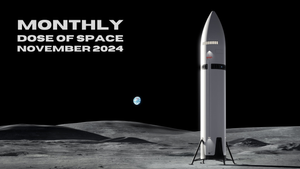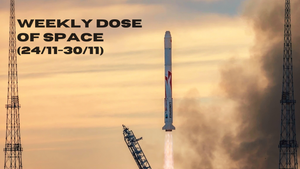
Weekly Dose of Space (16/6-22/6)
Welcome back to Weekly Dose of Space! Last week saw four orbital launch attempts worldwide, with all successfully delivering their payloads. This week also saw Ariane 6 move closer to launch, Starliner extending its stay at the International Space Station, and Rocket Lab receiving its largest launch contract. As always, we'll also look ahead to the launch schedule worldwide for next week.
SpaceX
This week at Starbase began on the 16th, when teams were spotted installing walls between each corner of the base of the second orbital launch tower, the remaining two corners were installed between the publication of last week's newsletter and the 16th. Ship 30 was also still having its thermal protection tiles replaced ahead of the fifth test flight.
A couple of days later on the 18th, the Ship quick disconnected was straightened and returned to its normal position for connecting to Starships. On the 19th, the scrapping of yet another old tank shell from the vertical tank farm began, these old tanks were planned to be adequate to fuel a full Starship-Super Heavy stack but their height has made them prone to debris strikes during flight tests.
Booster 14.1, which is a test article, was spotted departing the Massey's test site, on the 21st, and arrived at the launch site. After arriving it was lifted onto the orbital launch mount. The reasoning for SpaceX doing this is unknown as Booster 14.1 is shorter than the Starships.
Launches This Week
June 19th - Falcon 9 with Starlink Group 9-1
SpaceX broke last week's launch lull with a Falcon 9 carrying twenty Starlink satellites into low Earth orbit from Space Launch Complex 4E, in California. The booster for this mission was B1082 on its fifth flight, with it successfully landing downrange on the drone ship 'Of Course I Still Love You'.

June 20th - Electron for 'No Time Toulouse'
Rocket Lab launched its fiftieth Electron rocket with it carrying five satellites for Kinéis' 'Internet of Things' constellation. The rocket flew from Launch Complex 1B, located on the Māhia Peninsula in New Zealand, to sun-synchronus orbit.

June 20th - Falcon 9 with Astra 1P/SES-24
Another Falcon 9 launched last week, this time from Space Launch Complex 40, in Florida, carrying SES's Astra 1P/SES-24 spacecraft to a geostationary transfer orbit. The booster for this mission was B1080 making its ninth flight and landing successfully on the drone ship 'Just Read The Instructions' downrange.

June 22nd - Long March 2C with SVOM
A Long March 2C blasted off from the Xichang Satellite Launch Center carrying the French-Chinese SVOM spacecraft, which will help detect gamma-ray bursts. The Long March 2C successfully placed the spacecraft into its desired low Earth orbit, where it is expected to begin operation in the coming weeks. Sadly, this mission saw the Long March 2C booster landing near a residential area. While the booster was within one of the designated disposal zones, the local government did not evacuate the surrounding area properly. Thus, people could have been put in harms way. Instances like this aren’t excusable, but they are thankfully being tackled by the Chinese government. It was also reported that the debris and other toxic material was cleaned up properly by Chinese officials shortly after the booster crashed. For more about this specific mission click here.

In Other Space News
Starliner return delayed into July

Boeing and NASA have 'indefinitely' delayed the return of the Starliner spacecraft from the International Space Station, as both organizations work to understand ongoing propulsion and helium leak problems on the spacecraft. Starliner is currently docked to the International Space Station as part of the the Crew Flight Test mission, carrying astronauts Sunita Williams and Barry E. Wilmore.
Steve Stich, NASA's Commercial Crew Program Manager, said the following about the delay:
“We are taking our time and following our standard mission management team process,” – “We are letting the data drive our decision making relative to managing the small helium system leaks and thruster performance we observed during rendezvous and docking.”
NASA has previously said that the Starliner spacecraft for the Crew Flight Test mission can stay docked for up to forty-five days if needed. In the event that the crew of the flight test has to stay aboard the station, NASA believes that there are enough supplies onboard to accommodate the two additional astronauts. NASA currently believes that Williams and Wilmore will return to Earth aboard the Starliner spacecraft.
China conducts first 10-kilometer altitude landing test

The Shanghai Academy of Spaceflight Technology completed China's first 10-kilometer vertical-takeoff vertical-landing test 'hop' on June 23rd. This test occurred at the Jiuquan Satellite Launch Center, with three engines igniting to carry the test vehicle skyward.
The test vehicle is claimed to have three engines installed to produce 70 tons of thrust each while burning liquid oxygen and liquid methane. The flight profile for the test had all three engines igniting for ascent, with the outer two shutting off near the peak of the flight profile to begin descent. After the vehicle had passed through the descent phase, it performed a partial hover at fifty meters above the landing site while deploying its four landing legs. From liftoff to landing, the flight is reported to have lasted approximately six minutes.
Both the Shanghai Academy of Spaceflight Technology and China Aerospace Science and Technology Corporation have said the test was a success and the first of its kind. The China Aerospace Science and Technology Corporation believes that the test had a maximum altitude of just over 12 kilometers.
Ariane 6 completes wet dress rehearsal ahead of debut flight

The European Space Agency announced on June 21st that the agency and its various partners had completed a wet dress rehearsal of Araine 6 the day before, on June 20th. The rehearsal had the rocket fully loaded with liquid hydrogen and liquid oxygen in its first and second stages, as well as going through the countdown almost up until engine ignition.
The European Space Agency stated that it would take up until June 26th to go through all the data from the wet dress rehearsal. The agency also believes there are currently no 'showstoppers' ahead of launch on July 9th.
Synspective orders Rocket Labs' largest launch contract

On June 17th, Rocket Lab and Synspective announced that they had signed a contracted for ten Electron rocket launches, the biggest order of Electron launches to date.
The contract between the two companies covers the launch of individual StriX synthetic aperture radar satellites, manufactured by Synspective, from 2025 to 2027. These ten launches are to support Synspective's plans for a constellation of thirty StriX spacecraft by 2030.
Motoyuki Arai, Chief Executive Officer of Synspective, said the following about the order of ten launches:
“We look to accelerate building our satellite constellation and expand our services in the future. We appreciate Rocket Lab’s significant role in moving our business forward.”
Rocket Labs Peter Beck also commented on the contract signing saying:
“We are honored that the Synspective team has once again entrusted Rocket Lab with the deployment of their constellation and we’re proud to be their launch partner for another ten missions"
What to Expect Next Week
Starbase
SpaceX is still in the process of preparing both vehicles for the fifth flight test of Starship-Super Heavy. This week the U.S. Federal Communications Commission gave SpaceX the necessary approval to use certain communications frequencies between the ground and both vehicles. The approval also hinted that the company may be aiming to land the Super Heavy booster back at Starbase, on the 'chopsticks' of the launch tower. At the time of writing, SpaceX has not received a launch license to legally launch the next flight test.
June 23rd - Falcon 9 with Starlink Group 10-2
SpaceX is expected to launch a Falcon 9 carrying another batch of Starlink satellites to low Earth orbit, from Florida. The booster is believed to be B1078 on its eleventh flight.
June 24th - Falcon 9 with Starlink Group 9-2
SpaceX is expected to launch another batch of Starlink Satellites atop of Falcon 9, from California. The booster is believed to be B1075 also on its eleventh flight.
June 25th - Falcon Heavy with GOES-U
A Falcon Heavy is expected to liftoff from Launch Complex 39A, in Florida, next week carrying the GOES-U satellite to a geostationary transfer orbit on behalf of the U.S. National Oceanic and Atmospheric Administration. The core booster is B1087 on its first and final flight, the two side boosters are B1072 and B1086 making their first flight and landing attempts back in Florida.
June 27th - Firefly Alpha for 'Noise of Summer'
Firefly Aerospace is expected to launch its Firefly Alpha rocket from Space Launch Complex 2W, in California, carrying eight CubeSats for NASA's ELaNa 43 mission. The rocket will place the eight satellites into a low Earth orbit.
June 27th - Falcon 9 with Starlink Group 10-3
Another Falcon 9 is expected to launch next week, carrying yet more Starlink satellites to low Earth orbit. The booster for this mission is currently unknown.




